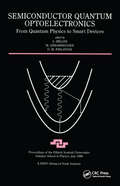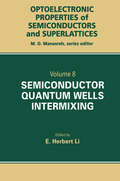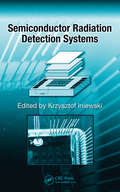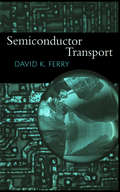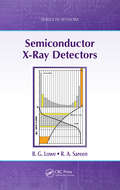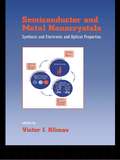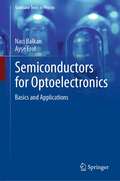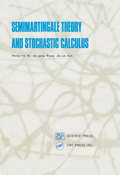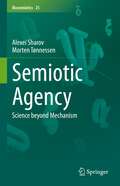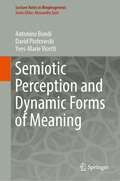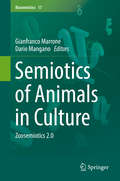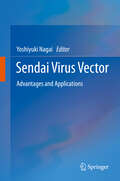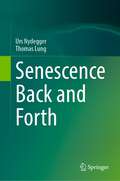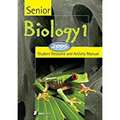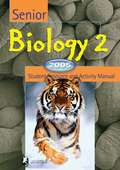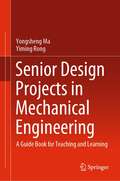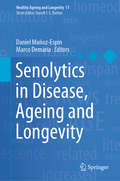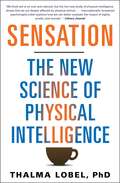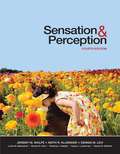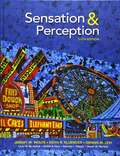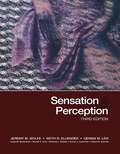- Table View
- List View
Semiconductor Quantum Optoelectronics: From Quantum Physics to Smart Devices (Scottish Graduate Ser. #50)
by A Miller; M Ebrahimzadeh; D M FinlaysonThe development and application of low-dimensional semiconductors have been rapid and spectacular during the past decade. Ever improving epitaxial growth and device fabrication techniques have allowed access to some remarkable new physics in quantum confined structures while a plethora of new devices has emerged. The field of optoelectronics in particular has benefited from these advances both in terms of improved performance and the invention of fundamentally new types of device, at a time when the use of optics and lasers in telecommunications, broadcasting, the Internet, signal processing, and computing has been rapidly expanding. An appreciation of the physics of quantum and dynamic electronic processes in confined structures is key to the understanding of many of the latest devices and their continued development.Semiconductor Quantum Optoelectronics covers new physics and the latest device developments in low-dimensional semiconductors. It allows those who already have some familiarity with semiconductor physics and devices to broaden and expand their knowledge into new and expanding topics in low-dimensional semiconductors. The book provides pedagogical coverage of selected areas of new and pertinent physics of low-dimensional structures and presents some optoelectronic devices presently under development. Coverage includes material and band structure issues and the physics of ultrafast, nonlinear, coherent, intersubband, and intracavity phenomena. The book emphasizes various devices, including quantum wells, visible, quantum cascade, and mode-locked lasers; microcavity LEDs and VCSELs; and detectors and logic elements. An underlying theme is high-speed phenomena and devices for increased system bandwidths.
Semiconductor Quantum Well Intermixing: Material Properties and Optoelectronic Applications
by E. Herbert LiSemiconductor Quantum Well Intermixing is an international collection of research results dealing with several aspects of the diffused quantum well (DFQW), ranging from Physics to materials and device applications. The material covered is the basic interdiffusion mechanisms of both cation and anion groups as well as the properties of band structure
Semiconductor Radiation Detection Systems (Devices, Circuits, and Systems)
by Krzysztof IniewskiSemiconductor Radiation Detection Systems addresses the state-of-the-art in the design of semiconductor detectors and integrated circuit design, in the context of medical imaging using ionizing radiation. It addresses exciting new opportunities in X-ray detection, Computer Tomography (CT), bone dosimetry, and nuclear medicine (PET, SPECT). In addition to medical imaging, the book explores other applications of semiconductor radiation detection systems in security applications such as luggage scanning, dirty bomb detection, and border control. Features a chapter written by well-known Gamma-Ray Imaging authority Tadayuki Takahashi Assembled by a combination of top industrial experts and academic professors, this book is more than just a product manual. It is practical enough to provide a solid explanation of presented technologies, incorporating material that offers an optimal balance of scientific and academic theory. With less of a focus on math and physical details, the author concentrates more on exploring exactly how technologies are being used. With its combined coverage of new materials and innovative new system approaches, as well as a succinct overview of recent developments, this book is an invaluable tool for any engineer, professional, or student working in electronics or an associated field.
Semiconductor Transport (Physics Of Solids And Liquids Ser. #52)
by David FerryThe information revolution would have been radically different, or impossible, without the use of the materials known generically as semiconductors. The properties of these materials, particularly the potential for doping with impurities to create transistors and diodes and controlling the local potential by gates, are essential for microelectronics.Semiconductor Transport is an introductory text on electron transport in semiconductor materials and is written for advanced undergraduates and graduate students. The book provides a thorough treatment of modern approaches to the transport properties of semiconductors and their calculation. It also introduces those aspects of solid state physics, which are vitally important for understanding transport in them.
Semiconductor X-Ray Detectors (ISSN #12)
by B. G. Lowe R. A. SareenIdentifying and measuring the elemental x-rays released when materials are examined with particles (electrons, protons, alpha particles, etc.) or photons (x-rays and gamma rays) is still considered to be the primary analytical technique for routine and non-destructive materials analysis. The Lithium Drifted Silicon (Si(Li)) X-Ray Detector, with its
Semiconductor and Metal Nanocrystals: Synthesis and Electronic and Optical Properties (Optical Science And Engineering Ser.)
by Victor I. KlimovThe vast technological potential of nanocrystalline materials, as well as current intense interest in the physics and chemistry of nanoscale phenomena, has led to explosive growth in research on semiconductor nanocrystals, also known as nanocrystal quantum dots, and metal nanoparticles. Semiconductor and Metal Nanocrystals addresses current topics impacting the field including synthesis and assembly of nanocrystals, theory and spectroscopy of interband and intraband optical transitions, single-nanocrystal optical and tunneling spectroscopies, electrical transport in nanocrystal assemblies, and physical and engineering aspects of nanocrystal-based devices. Written by experts who have contributed pioneering research, this reference comprises key advances in the field of semiconductor nanocrystal quantum dots and metal nanoparticles over the past several years. Focusing specifically on nanocrystals generated through chemical techniques, Semiconductor and Metal Nanocrystals Merges investigative frontiers in physics, chemistry, and engineeringDocuments advances in nanocrystal synthesis and assemblyExplores the theory of electronic excitations in nanoscale particlesPresents comprehensive information on optical spectroscopy of interband and intraband optical transitionsReviews data on single-nanocrystal optical and tunneling spectroscopiesWeighs controversies related to carrier relaxation dynamics in ultrasmall nanoparticlesDiscusses charge carrier transport in nanocrystal assemblies Provides examples of lasing and photovoltaic nanocrystal-based devices Semiconductor and Metal Nanocrystals is a must read for scientists, engineers, and upper-level undergraduate and graduate students interested in the physics and chemistry of nanoscale semiconductor and metal particles, as well as general nanoscale science.
Semiconductors for Optoelectronics: Basics and Applications (Graduate Texts in Physics)
by Naci Balkan Ayşe ErolThis book provides in-depth knowledge about the fundamental physical properties of bulk and low dimensional semiconductors (LDS). It also explains their applications to optoelectronic devices. The book incorporates two major themes. The first theme, starts from the fundamental principles governing the classification of solids according to their electronic properties and leads to a detailed analysis of electronic band structure and electronic transport in solids. It then focuses on the electronic transport and optical properties of semiconductor compounds, size quantization and the analysis of abrupt p-n junctions where a full analysis of the fundamental properties of intrinsic and doped semiconductors is given. The second theme is device-oriented. It aims to provide the reader with understanding of the design, fabrication and operation of optoelectronic devices based on novel semiconductor materials, such as high-speed photo detectors, light emitting diodes, multi-mode and single-mode lasers and high efficiency solar cells. The book appeals to researchers and high-level undergraduate students.
Semimartingale Theory and Stochastic Calculus
by Sheng-Wu He Jia-Gang Wang Jia-an YanSemimartingale Theory and Stochastic Calculus presents a systematic and detailed account of the general theory of stochastic processes, the semimartingale theory, and related stochastic calculus. The book emphasizes stochastic integration for semimartingales, characteristics of semimartingales, predictable representation properties and weak convergence of semimartingales. It also includes a concise treatment of absolute continuity and singularity, contiguity, and entire separation of measures by semimartingale approach. Two basic types of processes frequently encountered in applied probability and statistics are highlighted: processes with independent increments and marked point processes encountered frequently in applied probability and statistics. Semimartingale Theory and Stochastic Calculus is a self-contained and comprehensive book that will be valuable for research mathematicians, statisticians, engineers, and students.
Semiotic Agency: Science beyond Mechanism (Biosemiotics #25)
by Alexei Sharov Morten TønnessenThis book invites readers to embark on a journey into the world of agency encompassing humans, other organisms, cells, intracellular molecular agents, colonies, populations, ecological systems, and artificial autonomous systems. We combine mechanistic and non-mechanistic approaches in the analysis of the function and evolution of organisms, their subagents, and multi-organism systems, and in this way offer a theoretical platform for integrating biosemiotics with both natural science and the humanities/social sciences. Agents are autonomous systems that incorporate knowledge on how to make sense of their environment and use it to achieve their goals. The functions of all agents are supported by mechanisms at the lowest level; however, the explanatory power of mechanistic analysis is not sufficient for complex agents. Non-mechanistic methods rely on the goal-directedness of agents whose dynamics follow self-stabilized dynamic attractors. The properties of attractors depend on stable or slowly changing factors, and such dependencies can be interpreted as sign relations if they are adaptive in nature. Agents can replace or redirect mechanisms on demand in order to preserve their functions; for performing higher-level semiotic functions, mechanisms are thus only means. We assume that mechanism and semiosis are not mutually exclusive, and that simple agents can interpret signs mechanistically. This assumption allows us to extend semiotic analysis to all agents, including ribosomes in cells, computers, and robots. This book challenges established traditions in natural science and the humanities/social sciences: semiotics no longer appears as restricted to humans and rational thinking, and biology is no longer limited to rely exclusively on mechanistic reasoning.
Semiotic Perception and Dynamic Forms of Meaning (Lecture Notes in Morphogenesis)
by David Piotrowski Antonino Bondi Yves-Marie VisettiWhat do we mean by semiotic perception? Why should the concepts of perception and expressivity be reinterpreted within the encompassing framework of a dynamic theory of semiotic fields and forms? Can we redeploy the concept of form in such a way as to make explicit such a native solidarity (‘chiasmatic’ would have said Merleau-Ponty) between perception, praxis and expression -- and first and foremost in the activity of language, right to the heart of the life of the social and speaking animal that we are? What then would be the epistemological and ontological consequences, and how might this affect the way we describe semiolinguistic forms? This book aims to provide answers to these questions by opening up avenues of research on how to understand the linguistic and semiotic dimensions at work in the constitution of experience, both individual and collective.
Semiotics of Animals in Culture: Zoosemiotics 2. 0 (Biosemiotics Ser. #17)
by Gianfranco Marrone Dario ManganoTo place animals within the realm of nature, means inserting them among the articulations of culture and the social. Semiotics has never avoided this chiasmus, choosing to deal from the outset with the problem of the languages of animals following the old admonition of Montaigne: it is not that animals do not talk, it is us who do not understand them.Recent research in the field of the anthropology of nature and sociology of sciences and techniques allow to think about the Zoosemiotic issue in a different way. Instead of transplanting the language structures – gestures, LIS, etc. – for a semiotic study of the forms of the human and social meaning, it seems more apt to look at their discourse, and as such, the actual interactions, communicative and scientific as well as practical and functional, between humans and non-humans. This book aims to investigate precisely this hypothesis, known here as Zoosemiotics 2.0, working on several fronts and levels:· Anthropology· Languages of the image and visual representations, from art history to cinema· Old and new media. From literature to comics, from cartoons to TV documentaries but also advertising, music, Web and social networks. All those cultural products that talk about the role of human and non-human in society implicitly proposing (and in some way imposing) a form of articulation of such a relationship.· Food and feeding rites· Animalist, vegetarian and vegan movements · Philosophy: metaphysics, ethics, aesthetics
Sendai Virus Vector
by Yoshiyuki NagaiSendai virus (SeV) is not just a mouse pathogen but is evolving into a cutting-edge component of biotechnology. SeV reverse genetics originating from a pure academic need to settle long-held questions in the biology and pathogenicity of nonsegmented negative strand RNA viruses (Mononegavirales) is about to bear the impressive fruit of multipurpose cytoplasmic (non-integrating) RNA vectors. This book brings together in one source the SeV biology revealed by conventional approaches and reverse genetics, the methods to construct the first-generation SeV vector and to generate safer versions, and the applications in medical settings that have left or are about to leave the laboratory bench. The applications, which already are diverse and have high medical impact, include use as vaccine vectors against AIDS and respiratory virus infections, creation of BioKnife to resect malignant tumors, induction of "footprint (transgene) free" pluripotent stem cells, and gene therapy for peripheral arterial disease. These achievements--which are just a few of many examples--were attainable only after rigorously incorporating the rich knowledge of SeV biology that has accumulated during the several decades since the discovery of the virus. Application of SeV vector is certain to expand greatly because of its extremely high performance in transgene expression and its remarkable target cell breadth.
Sending Messages with Light and Sound
by Jennifer BoothroydYoung readers will learn how we send and receive messages using light and sound in this accessible, photo-filled book. Simple text explains different methods of sending messages and shows how light and sound make sending these messages possible. Vibrant photos bring basic science concepts to life and encourage kids to explore light and sound on their own.
Sending Signals (Smithsonian Science Stories)
by Life ReaderLet in the Light, Sensible Structures, Seeing with Sound, Animals with something to say, Life as an Animal behavior Scientist, Seeking The Sun, Faster than a Flying Pigeon, Living light Bulbs.
Senescence Back and Forth
by Urs Nydegger Thomas LungThis book is about lifelong ageing of humans. The basic biochemical and genetic mechanisms remain ill known, and differ among individuals. The book starts out to explore the plant and animal kingdoms to answer questions human ageing needs for understanding. First, we come to scrutinize time running out and what ‘normal’ means with impacts on the genome and on protein half- lives and function. Ageing goes beyond biochemical skid treated by geroprotector drugs, including biosimilars; albeit early diagnosis with standard medical laboratory assays, here addressed, sheds light with focus on basic research. Modern tools, including machine learning, and DNA technology, e.g. genomics, have already provided for unanticipated insights. The chapters then turn around senescence of the entire organism based on variable ageing of single organs embedded in neuronal networks . Psychological stress factors, dementia opposed to vigilance, and distinction of ageing from overt disease are contrasting in humans and are opposed in the book. Senescence, seen as a one way track may be reverted into rejuvenation, made possible by insights into immunosenescence and genomic approaches. Risk management in health insurance finds important clues in this book. The topics addressed between the book covers help to understand the trend to the ever- prolonging life expectancy beyond the centenarian age group; nursing care takers and pharmaceutical industry are invited to understand what’ is going on in senior people to make their geriatric population remain fit or become frail.
Senior Biology 1 Fourth Edition
by Tracey Greenwood Richard Allan Lyn ShepherdThis is the fourth edition of Senior Biology 1. It is designed to meet the needs of students undertaking biology at grades 11 and 12 or equivalent. It is particularly well suited to students taking Advanced Placement (AP), Honors Biology, or International Baccalaureate courses.
Senior Biology 2: Student Resource and Activity Manual (Fourth Edition)
by Tracey Greenwood Richard Allan Lyn ShepherdSenior Biology 2 - 2005: Student Resource and Activity Manual, Fourth Edition is designed to meet the needs of students undertaking biology at grades 11 and 12 or equivalent. It is particularly well suited to students taking Advanced Placement (AP), Honors Biology, or International Baccalaureate courses.
Senior Design Projects in Mechanical Engineering: A Guide Book for Teaching and Learning
by Yongsheng Ma Yiming RongThis book offers invaluable insights about the full spectrum of core design course contents systematically and in detail. This book is for instructors and students who are involved in teaching and learning of ‘capstone senior design projects’ in mechanical engineering.It consists of 17 chapters, over 300 illustrations with many real-world student project examples.The main project processes are grouped into three phases, i.e., project scoping and specification, conceptual design, and detail design, and each has dedicated two chapters of process description and report content prescription, respectively. The basic principles and engineering process flow are well applicable for professional development of mechanical design engineers.CAD/CAM/CAE technologies are commonly used within many project examples. Thematic chapters also cover student teamwork organization and evaluation, project management, design standards and regulations, and rubrics of course activity grading. Key criteria of successful course accreditation and graduation attributes are discussed in details. In summary, it is a handy textbook for the capstone design project course in mechanical engineering and an insightful teaching guidebook for engineering design instructors.
Senolytics in Disease, Ageing and Longevity (Healthy Ageing and Longevity #11)
by Marco Demaria Daniel Muñoz-EspinThis book offers comprehensive information on the new and rapidly evolving science of identifying and targeting senescent cells, and on the exciting prospect of new diagnostic and therapeutic opportunities for stopping, and even reversing, the progression of disease and the deterioration of the human body due to ageing. According to recent United Nations data, by 2050 one in six people worldwide will be older than age 65, with peaks rising to one in four people in Europe and North America. Remarkably, the number of persons aged 80 years or older is expected to triple, from 143 million in 2019 to 426 million in 2050. First documented in the 1960s, the concept of cellular senescence as an underlying cause of ageing has been established in the course of the last decade. Using genetically engineered mouse models, researchers have demonstrated that the selective elimination of senescent cells can block and even reverse a number of age-related dysfunctions and pathologies, promoting both better health and longer life in the elderly. These include cardiovascular diseases; neurological disorders; type 1 and type 2 diabetes; inflammatory diseases; fibrosis; geriatric syndromes; chronic diseases resulting in organ dysfunction; the integrity of the musculoskeletal system; and cancer. Some senolytic agents have already progressed into trials. These include UBX0101 for the treatment of osteoarthritis (now in phase II), a cocktail of dasatinib and quercetin for the management of idiopathic pulmonary fibrosis and chronic kidney disease, and ABT-263 in combination with senescence-inducing chemotherapies for the treatment of advanced solid tumours. In addition, the book discusses pathways to early phase clinical trials and translational approaches in medicine and ageing, highlighting new opportunities as well as current limitations, challenges and alternatives. Given its scope, it will benefit a broad audience of advanced educators, researchers, graduate students and practitioners.
Sensation
by Thalma LobelLike the revolutionary bestsellers Predictably Irrational and Emotional Intelligence, Sensation is an exciting, completely new view of human behavior--a new psychology of physical intelligence (or embodied cognition)--that explains how the body unconsciously affects our everyday decisions and choices, written by one of the world's leading psychologists.From colors and temperatures to heavy objects and tall people, a whole symphony of external stimuli exerts a constant influence on the way your mind works. Yet these effects have been hidden from you--until now. Drawing on her own work as well as from research across the globe, Dr. Thalma Lobel reveals how shockingly susceptible we are to sensory input from the world around us. An aggressive negotiator can be completely disarmed by holding a warm cup of tea or sitting in a soft chair. Clean smells promote moral behavior, but people are more likely to cheat on a test right after having taken a shower. Red-colored type causes us to fail exams, but red dresses make women sexier and teams wearing red jerseys win more games. We take questionnaires attached to heavy clipboards more seriously and believe people who like sweets to be nicer. Ultimately, the book's message is startling: Though we claim ownership of our decisions, judgments, and values, they derive as much from our outside environment as from inside our minds. Now, Sensation empowers you to evaluate those outside forces in order to make better decisions in every facet of your personal and professional lives.
Sensation & Perception (Fourth Edition)
by Jeremy M. Wolfe Keith R. Kluender Dennis M. Levi Linda M. Bartoshuk Rachel S. Herz Roberta Klatzky Susan J. Lederman Daniel M. MerfeldSensation & Perception is written by experts in each of the five senses who have a passion and enthusiasm for conveying the excitement of this field to students. Each of the 15 chapters of this book tells a coherent and interesting story that gives the reader enough background and exposure to enough current research to understand why these topics are interesting and how they might be further investigated and understood.
Sensation and Perception
by Rachel Herz Roberta Klatzky Linda Bartoshuk Jeremy Wolfe Keith Kluender Dennis Levi Daniel MerfeldSensation & Perception, Sixth Edition, introduces students to their own senses, emphasizing human sensory and perceptual experience and the basic neuroscientific underpinnings of that experience. The authors, specialists in their respective domains, strive to spread their enthusiasm for fundamental questions about the human senses and the impact that answers to those questions can have on medical and societal issues.
Sensation and Perception (Third Edition)
by Jeremy M. Wolfe Keith R. Kluender Dennis M. Levi Linda M. Bartoshuk Rachel S. Herz Roberta Klatzky Susan J. Lederman Daniel M. MerfeldThe book provides comprehensive descriptions of the science behind vision, hearing, touch, smell and taste.
Sensational: A New Story of our Senses
by Ashley WardOur senses are at the heart of how we navigate the world. Whittling this high-powered and deliciously varied palette down to just five does a great disservice to the sensory experience, Sensational argues. In fact, we could have as many as fifty-three - and they could explain such mysteries as why we kiss, in what way music is a form of emotional currency, and how a dairy-rich diet strained initial Euro-Japanese relations.Ashley Ward embarks on a sensory expedition to answer all these questions and more. Why do women have a better sense of smell than men? Has the iPhone changed how we touch? Does the Danube really look blue when you're in love?From the power of cuddling to what canine bowel movements can tell us about geomagnetic fields, Sensational is a surprising look at how our brains shape the way we interpret the world.
